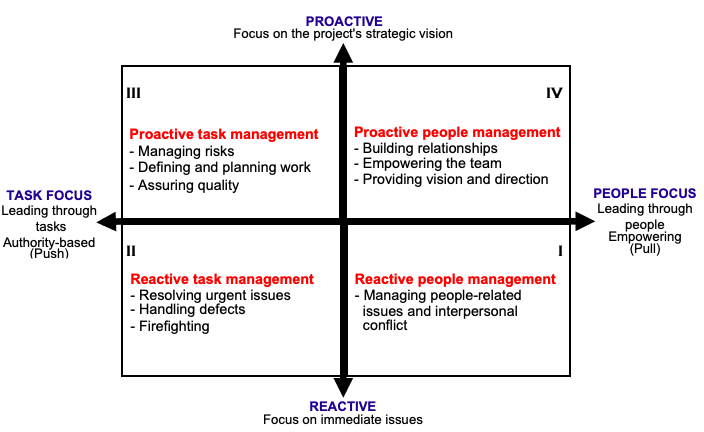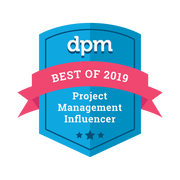We can gain further insight into project leadership – and how to get there - by examining The Project Leadership Matrix™.
On the contrary, people who operate on the right-hand side of the matrix have a natural tendency to focus on people. They don’t rely on their authority, but appeal to people by finding out what motivates each person at an individual level. People-focused leaders involve team members in the decisions that affect them and show them how they fit into the overall vision. They don’t just tell people what to do, but inspire them by painting an appealing picture of the project’s objectives that they would like them to contribute to. We can call this a pull approach. They pull people with them like a magnet instead of pushing, or forcing them.
If you are in doubt where on this scale you operate, think about how easy or difficult you find it to approach a person who doesn’t report to you. In matrix organizations, where team members don’t have an organizational reporting line to the project manager, we cannot rely on our authority to allocate work. This is a situation that task-oriented project managers find challenging – not least when the team member they need to interface with is in a senior position and has a lot of experience. In such situations we need to make use of our people and influencing skills and of our understanding of human behaviour rather than relying on authority.
Let’s examine the dimensions of the vertical axis, reactive versus proactive. People who operate in a reactive manner – towards the bottom of the matrix – are drawn to immediate issues that crop up. Even if they arrive at work with a clear intention of what they need to achieve, they may not achieve it because something urgent or unexpected comes up and derails them. They spend their time following the flow of events rather than defining it and are constantly on a back foot.
At the other end of the scale we find people with a proactive mindset. People who operate towards the top of the matrix are concerned with the project’s strategic vision and they take steps every single day to create a successful future for the project. They set their own agenda to the benefit of the project, the client and the team. They don’t make knee-jerk decisions and only firefight when a true crisis emerges that cannot wait and that no one else can deal with. In that situation they will strive to address the root causes and put in place measures to ensure that the issue doesn’t reoccur.
Although most of us operate in all four quadrants depending on the situation, we have a tendency to spend the majority of our time in one of them. Project managers who are not getting the results they want operate predominantly in quadrant number II. They spend too much time firefighting and dealing with events and tasks that urgently need to be resolved. They are good at getting things done but will never be successful at implementing a strategic change initiative as long as they operate from this space. The biggest sign that something is wrong is the lack of clear direction and the number of project issues that crop up – interpersonal or otherwise. Oftentimes projects are kicked off before they are fully defined, roles and responsibilities are unclear, rules of engagement haven’t been agreed, stakeholders are not engaged, requirements are too vague and objectives aren’t aligned to corporate strategy. Ultimately the project fails to deliver the expected benefits – or if it does deliver them, it’s a long and arduous road to getting there.
Project managers who get outstanding results tend to operate in the top part of the matrix – in between quadrant III and quadrant IV. They are proactive and focused on the project’s long-term strategy and they are partly oriented towards tasks and partly towards people. This is the domain of Project Leadership. Project leaders continue to be mindful of the task side of the project and will not be effective if they operate exclusively in quadrant IV. People who operate exclusively in quadrant IV have great ideas and are good at inspiring people, but will often have no concrete plans or operational strategies to back up their vision. Project leaders may also spend time in quadrants I and II, but it is not a strategy they rely on to get results.
Many project managers find if difficult to break out of the reactive and task-oriented pattern. They don’t see how they can free up time and energy to proactively deal with people and the strategic side of the project. They are caught in the reactive management trap and find it hard to shift their over-reliance on control and rational thinking to a more people-oriented approach of trust and openness. After all, most of us are trained in mastering the detail and in thinking logically rather than building relationships and leading people. In addition, the more-for-less culture isn’t helping. In many cases it may be increasing the workload and pushing people into a reactive and task-oriented mode.
But no matter why we find ourselves in these situations, there will always be ways around them by thinking creatively and knowing that we have a choice. We may not be able to change external factors, such as limited budgets, reduced workforces and a reactive company culture, but we can control how we respond to them, what we choose to focus on and how we influence people around us. I was almost at the point of giving up my job as a project manager in financial services because I found it to be too exhausting. Little did I know that my working patterns were self-imposed and not the fault of the industry, the company, the project, the client or my manager. It is easy to feel victimized and look for someone to blame outside of ourselves. But the reality is that we hold the answer and the key to working more effectively, getting better results, feeling more energized and working with people to deliver better projects. Had I left my job at that time I would have found the exact same problems elsewhere. Instead I started examining what I could do to change the situation. I started looking at how I could work smarter rather than harder.
- Look at The Project Leadership Matrix and determine where you operate most of the time. Do you have a natural preference for tasks or people?
- Do you rely on your authority over people, or do you inspire and influence people at an individual level?
- Are you good at attending to important activities that lead to success of your project, or do you often get side-tracked and interrupted?
If you liked this post, you may also like:
Deep Work: How to embrace this superpower of the 21st century
What are the differences between management and leadership?
7 essential time management strategies
The Secret to Authentic Leadership
Delegate Effectively and Thouhtfully
How to increase your wellbeing as a project manager









 RSS Feed
RSS Feed